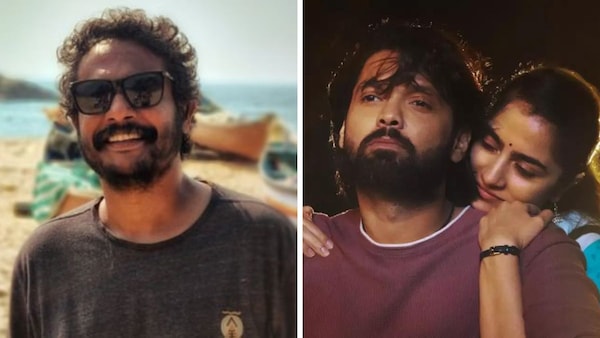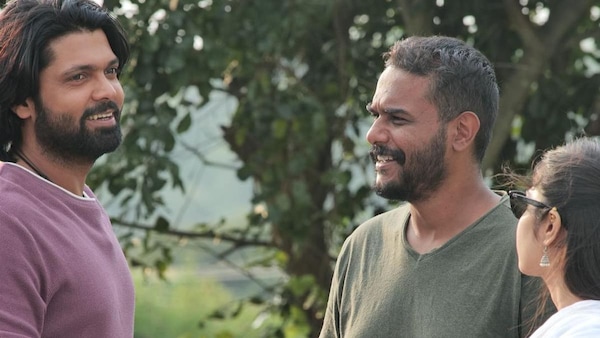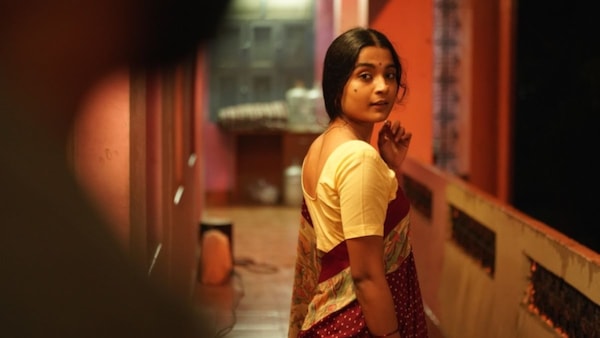When People ‘Get’ My Writing, There’s A Beautiful Connect: Hemanth M Rao
Sapta Sagaradaache Ello director Hemanth M Rao talks to Subha J Rao about completing both parts of the film - Side A and Side B - on his own terms and exactly as he envisioned it.

Last Updated: 09.11 AM, Mar 13, 2024
WHILE THE AUDIENCE FELT, and is still feeling all the feels after watching both parts of Hemanth M Rao’s Sapta Sagaradache Ello, the director has this overwhelming sense of lightness and relief. He’s carried the heavy subject for far too long within him, and was able to complete the project on his terms and the way he envisioned it. “I felt like a huge weight was off my shoulder,” says Hemanth, about the films which have touched a wider audience after their release on Amazon Prime Video.
And, even better, it has thrown forth wonderful observations about the film that many might have missed during a first watch. A more mindful watch within the intimate space of a home is where the film reveals itself, layer by aching layer.
Like, X user Sai Pradeep who found the connection between a segment of the background score and the last male Kauai O’o bird singing for a female who would never come. Hemanth wrote: “Wow! I can't believe someone picked up on this. Only one other person has identified the sound so far, Gautham from Charan's music team. I had read about this group of scientists who went around capturing the last sounds of animals going extinct. I was incredibly moved when I heard the male kauai bird song. I knew instantly that I'd be using it for this sequence.”
Hemanth says that he does not expect everyone to ‘get’ his reason for writing a scene in a particular way or a certain nuance in it, but when they do, there’s a beautiful connect. Following are edited excerpts from an interview with the filmmaker.
Do you ever see yourself making a full romance, considering you made so many sigh with love and ache with SSE?
I’ve not really thought about it. It’s a genre I like writing and I quite enjoy those emotions, especially while writing SSE. I don’t rule out dabbling in this genre again, but that’s not happening anytime soon. The kind of person I am, I like to make something dramatically different, and reset myself creatively. I am a sucker for classic old-school romance. I have many favourites. Almost all of Mani (Ratnam) Sir’s filmography is a huge inspiration. A lot of French New Wave films, and old-school Bollywood romance have influenced me.
The kind of love stories I like are closer in definition and representation of how love finds its way in everyday life. Translating that on screen, however, is very demanding. It is a lot of work and conflict.
Very rarely in real life do you meet someone and everything works out. That’s an exception, not the rule. Most love stories are full of trials, they are burnished by time, distance, and money.
Love comes with a certain expiry date, and you develop the ability to constantly morph into different shapes and forms. That makes some feel things are not like what they were before. But, rarely do we realise that love is also evolution. That’s an interesting world to explore.
You’ve turned 'kaththe' into such a love term...
In many Indian languages, especially Kannada which I grew up with, we use words that are usually used as insults – kappe (frog), goobe (owl) – as terms of endearment.
I think when you like someone so much, you find a cute name for them. It happens organically.
The core idea is that every couple has their own love language. If I had set the film in a slightly more affluent setting, maybe, 'baby' or 'babe' might have been natural, but because of where Manu and Priya come from, kaththe (donkey) sat very well. The audience felt the usage was right because they understood who Manu and Priya were as people.

Manu and Priya and their friends and family were very rooted. You showed a side of Bangalore that’s not often seen on screen...
I firmly believe that if you’re trying to root the film in a certain reality, you first familiarise yourself with that milieu.
I know where the characters come from, the locality they live in… I’ve gone there numerous times, sometimes with my team, before the final recce with my art director and cinematographer. I make mental notes, observe the place minutely. In fact, I’ve not done a lot of sets for my earlier films, but the house here was a set. It was rather uncomfortable to start with, but we did enough homework to ensure it does not look like a set.
If you take Priya’s marital home, it’s crammed with things that might find use someday. That’s because we in India see prospective value in everything.
After Manu's release, his room looks a certain way because he is mentally in such a space. The seedy hotels in the film? We researched where sex workers go. That helped me understand their perspective on life. Recreating that is a reflection of your research.
Your SSE Side A and B possibly had the shortest of gaps during release. How did you manage to create two very distinct worlds?
We visualised both parts differently, and we knew that Rakshit had to put on weight post the jail portion. Everything was preplanned – the look, the aesthetics.
The colours were not accidental. We knew that the first half of the film would be in blue, and the second in red. It was a conscious call.
You are someone who does not particularly like revisiting your films. How did you manage that with this film, because you had to work on Side B soon after Side A was out?
It was the first time I was going to put out a film in four languages. It was harrowing, it was also a very solitary exercise because most of the team had moved on once the work was done. I worked with a skeletal team.
It was stressful, I won’t deny. Charan and I had to get eight songs ready in four languages. We went through several bouts of anxiety and panic attacks. Completing it on time was a challenge we took up, but we managed it. But yes, I will take a lot of time to recover from that anxiety.

Everyone knows your integrity as a filmmaker and as someone who writes his women well. How did you react to the criticism of stalking in the film?
There are two characters throughout the film who keep questioning Manu’s actions and his decisions. Will I shoot myself in the foot by making a guy I’ve made you fall in love with stalk the women he loves? I would have liked a little more nuance in the understanding. I did not write the film to fit certain opinions or values the society has. I was true to the characters I created. He’s troubled and desperate and wants to somehow better her life that he ruined. Manu entering Priya’s house is not glorified. It is supposed to make you question his actions. Manu is in a prison of his own making and he’s stuck there. There’s no logic really in some of his actions.
At the same time, everyone seems to love how Surabhi is written, with a certain agency. I wish they saw the film the way it was meant to be seen, through the eyes of the characters, each of whom has witnessed emotional violence. Priya is married off to a man when she is emotionally and physically invested in a relationship. That’s violence too.
That said, I’d appreciate a conversation on pushing the boundaries, and the gender discourse here. When the entire effort is questioned with one brush stroke, you end up questioning your entire process, and the sensitivity that you wrote into the script. It is disappointing.
Taking such a stand denies the simple fact that love can involve a beautiful feeling and something extremely damaging too. If I don’t show the damaging part, I would not be doing justice to my story.

How did you relate to how the audience created their own explanations for certain scenes?
Once a film is out, it becomes the audience’s. And, they are allowed to make it theirs and see it the way they want to. I do not want to ruin some really interesting takes by telling them what I originally meant.
The audience is yet to really emerge from SSE. Have you?
Not quite. It will take me some time. But all I want to do is tell as many stories as possible, as a writer or director. A good filmography is a bonus.
Subscribe to our newsletter for top content, delivered fast.
